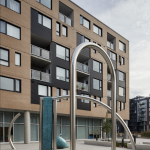

Marie-Michelle Deschamps’ work focuses on language as inhabitable space: a true structure and a place where aesthetic forms reside. Her practice is rooted in conversation, collaboration and translation, emphasizing the transformative power of language in the formal dialect of architecture.
Marie-Michelle Deschamps is based in Montreal, Canada, and holds an MFA from the Glasgow School of Art (Glasgow, Scotland). Works by Marie-Michelle Deschamps are included in the permanent collections of the Musée d’art contemporain de Montréal, the Musée Voorlinden (Wassenaar), the Fondation Lafayette (Paris), the Glasgow School of the Arts (Glasgow), the Enamel Arts Foundation (Los Angeles) and the Caisse de dépôt et placement du Québec (Montreal).
Artwork description
The artwork Réciprocités is composed of an installation of simple shapes, relating three large arches made of stainless steel and two bronze elements: a hanging frieze with cut-out silhouettes of plants; and, on the ground, giving the impression of having become detached from one of the arches, a sculpture in the form of a milkweed pod. The 16 botanical specimens that compose the bronze frieze, like the shape of the milkweed sculpture, are borrowed from the herbarium The Lost Flora of Montreal, by Andrew Fernando Holmes (1797–1860), the botanist and founder of McGill University’s faculty of medicine.
The tubular stainless-steel shapes of the three arches directly accentuate the industrial heritage of the Griffintown district.
Réciprocités bears witness to the exchange between the industrial past of the area and its current renewal. This work celebrates life returning to a flourishing neighbourhood.




